When Disaster Strikes: Understanding the Pipe Burst Emergency
An emergency pipe burst can transform a peaceful home into a water-logged disaster zone in minutes. When pipes fail suddenly, homeowners face thousands of dollars in potential damage, safety hazards from water mixing with electricity, and the urgent need to act fast.
Immediate Steps for a Pipe Burst Emergency:
- Shut off the main water valve - Stop the flow immediately
- Turn off electricity to affected areas - Prevent electrocution risks
- Open all faucets - Drain remaining water and relieve pressure
- Move belongings away from water damage
- Call a professional plumber for permanent repairs
Water damage from a burst pipe spreads quickly through your home. It can ruin flooring, walls, and ceilings while creating perfect conditions for dangerous mold growth. The sooner you act, the better you can limit the destruction.
Over 20 percent of homeowners insurance claims involve water damage, making burst pipes one of the most common and costly home emergencies. But knowing exactly what to do in those critical first moments can save you thousands in repairs and protect your family's safety.
The key is having a clear action plan before disaster strikes. Every minute counts when water is gushing through your home.
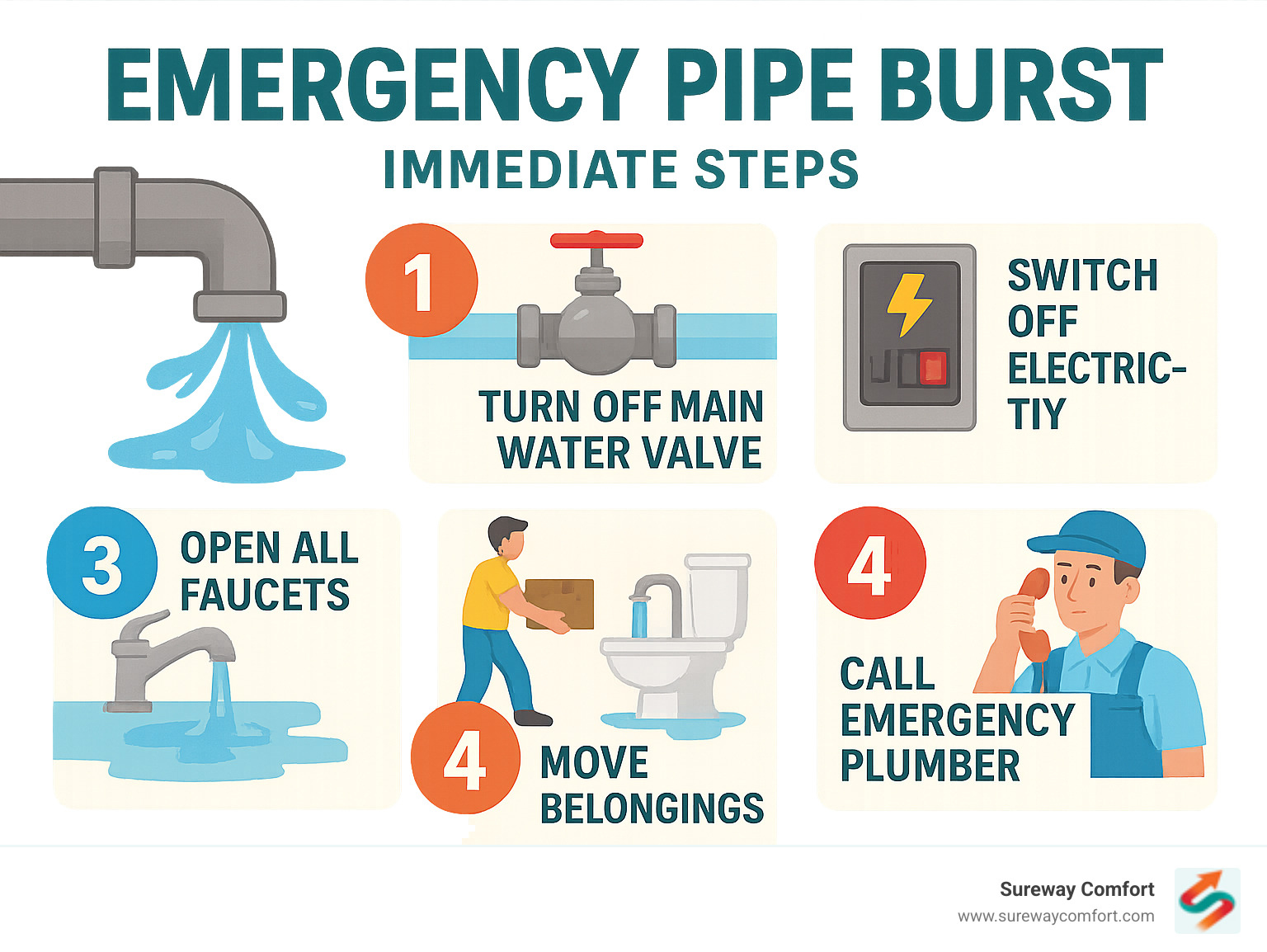
Quick look at Emergency pipe burst:
Your Emergency Pipe Burst Action Plan: What to Do Immediately
When an emergency pipe burst strikes, your heart might race, but staying calm is your superpower. Water gushing through your home creates a ticking clock situation where every second counts. The good news? Following a clear action plan can dramatically reduce the damage and keep your family safe.
Water and electricity are dangerous enemies, so practice safety first is rule number one. Never enter flooded areas where electrical outlets, appliances, or wiring might be submerged. Your safety is worth more than any possession.
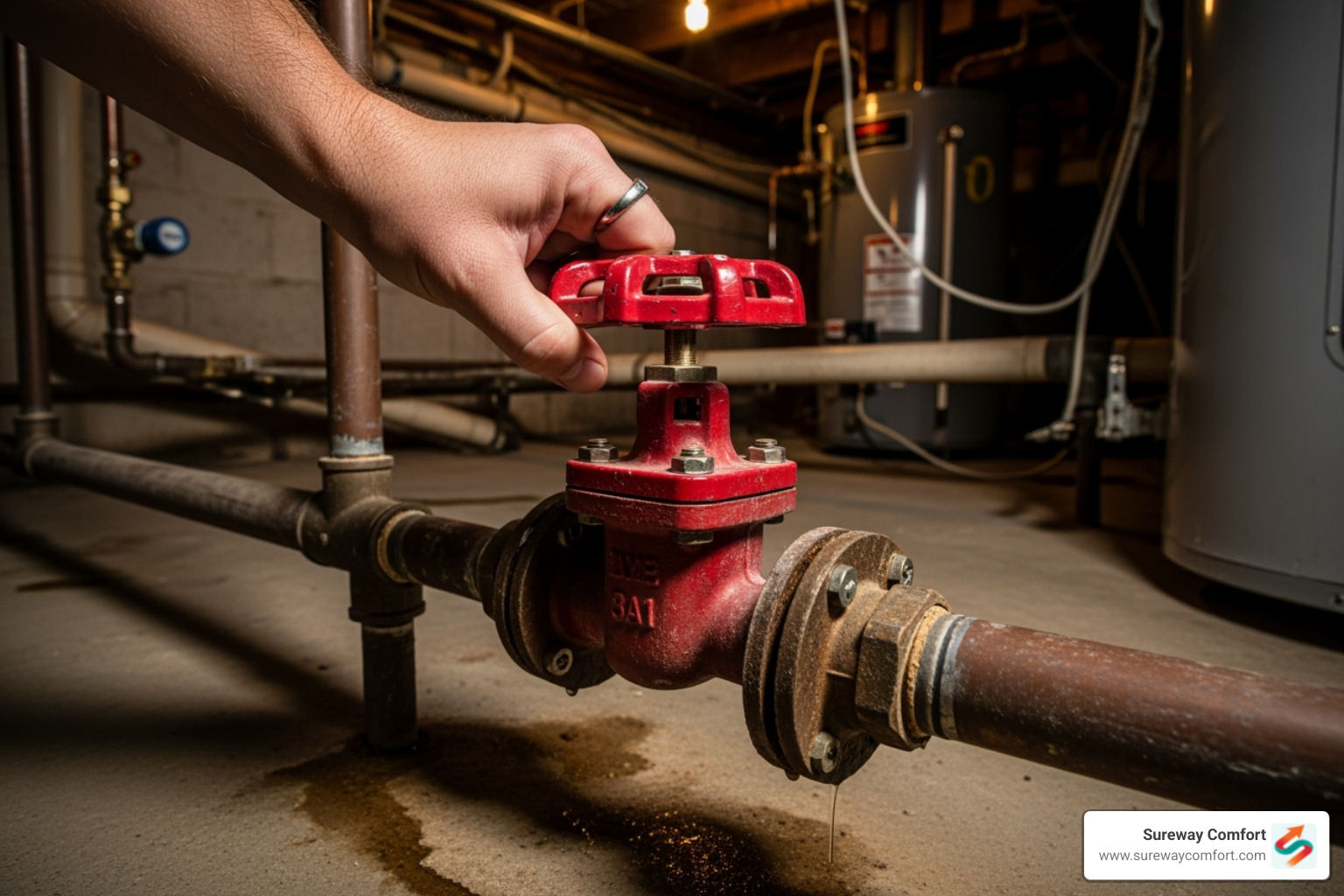
Step 1: Shut Off the Main Water Supply
The moment you find a burst pipe, race to your main water shut-off valve. This single action stops the flood in its tracks and prevents thousands of dollars in additional damage.
Most homes have their main valve in the basement near where water lines enter the house, in a utility closet, or sometimes in a crawl space. It might look like a wheel you turn clockwise or a lever you flip perpendicular to the pipe.
Here's the thing - if you don't know where your valve is right now, you're already behind. Take a few minutes this weekend to locate it and show every family member. When water is shooting everywhere, you don't want to be playing hide-and-seek with your shut-off valve.
Turn the valve clockwise (righty-tighty) until it stops. Don't force it if it's stuck - you might break it and create an even bigger problem.
Step 2: Turn Off the Electricity
Once you've stopped the water flow, electrical safety becomes your next priority. Water and electricity create a deadly combination that can cause electrocution or house fires.
Head to your circuit breaker box and flip off the breakers for any areas affected by flooding. If you're not sure which breakers control the flooded areas, it's safer to shut off power to that entire section of your house.
Never attempt this if water is actively flowing near your electrical panel. If the flood is severe and water is pouring onto outlets or light fixtures, evacuate everyone and call 911 immediately. Your life is more important than your house.
Step 3: Drain the System
With the main water supply off and electricity safely disconnected, it's time to relieve pressure in your plumbing system. This step helps prevent additional water from leaking out of the burst pipe.
Start on your home's highest floor and open all cold water faucets. Work your way down to the lowest level, opening every tap you can find. Don't forget to flush all toilets too - this helps drain water from the entire system.
You'll hear gurgling and see water flowing from the faucets initially. This is exactly what you want. Once the flow stops, you've successfully drained most of the remaining water from your pipes.
Temporary Fixes for an Emergency Pipe Burst
While you're waiting for professional help, a few temporary repairs can help minimize ongoing damage. Think of these as emergency bandages - they'll help, but they're not permanent solutions.
Pipe clamps with rubber gaskets work great for small leaks. Place a piece of rubber over the damaged area and secure it tightly with the clamp. Epoxy putty can seal smaller holes when you knead the two-part mixture together and press it firmly over the leak. Pipe repair tape creates a temporary seal when wrapped tightly around the damaged section - make sure to stretch it as you wrap for the best seal.
For larger breaks, try the rubber gasket and hose clamp method. Cut a piece of rubber from an old inner tube or buy a rubber sheet from the hardware store. Wrap it around the pipe and secure with hose clamps on both sides of the break.
These fixes are just buying you time. An emergency pipe burst needs professional repair to prevent future problems and ensure your plumbing system works safely for years to come.
Understanding the Problem: Signs and Causes of a Burst Pipe
Not all burst pipes announce themselves with a dramatic gush of water. Sometimes, they start as subtle leaks, hidden within walls or under floors, slowly causing damage before they become apparent. Understanding the signs and common causes can help you identify a problem early, potentially preventing a full-blown emergency pipe burst.

Telltale Signs of a Burst Pipe
Your home will often give you clues that something's wrong with your plumbing system - you just need to know what to look for. These warning signs can save you from dealing with a major emergency pipe burst down the road.
Water stains and damp spots are like your home's way of waving a red flag. If you notice unexplained discoloration on your ceilings, walls, or floors, don't ignore them. These marks often appear long before you see actual water flowing, giving you a chance to address the problem early.
Low water pressure throughout your home - or even in just one area - can signal trouble brewing in your pipes. When you turn on the shower and barely get a trickle, or your kitchen faucet suddenly lacks its usual force, water might be escaping somewhere it shouldn't.
Pay attention to discolored water coming from your taps. If your water looks rusty, cloudy, or smells strange, it could mean your pipes are corroding or there's contamination from a breach in your plumbing system.
Your ears can be just as helpful as your eyes. Gurgling sounds, hissing noises, or mysterious dripping coming from within your walls when no faucets are running often indicate water escaping from damaged pipes. These sounds are your plumbing system's cry for help.
Finally, keep an eye on your water bills. If your usage habits haven't changed but your bill suddenly jumps, you're probably paying for water that's leaking somewhere in your home instead of coming out of your faucets.
Common Causes of an Emergency Pipe Burst
Understanding why pipes burst can help you prevent problems before they start. Here in the Pittsburgh area, including Bridgeville, South Fayette, and Bethel Park, we see certain causes more often than others.
Freezing temperatures top the list as the most common culprit behind burst pipes. When water freezes inside your pipes, it expands and creates tremendous pressure. Contrary to what many people think, it's this pressure - not the ice itself - that actually causes the pipe to burst. The break often happens in a completely different section from where the initial freeze occurred.
Pipe corrosion is a sneaky problem that develops over time. Metal pipes gradually weaken due to corrosion, rust, or chemical reactions with your water supply. This process makes pipe walls thinner and more vulnerable to pressure. Homes with well water can be particularly susceptible to this issue.
High water pressure might sound like a good thing, but your pipes have limits. Sudden pressure surges or consistently liftd pressure can strain older or weaker pipes until they finally give way. Your plumbing system needs just the right amount of pressure to function properly.
Severe clogs can create dangerous pressure buildups behind the blockage. When water has nowhere to go, it pushes harder and harder against your pipes until something gives. This is especially problematic if your pipes are already compromised by age or other factors.
Old pipes and outdated materials simply reach the end of their useful life. Pipes made from galvanized steel or polybutylene are particularly prone to failure as they age. Even newer PVC pipes can become brittle over time, making them more likely to crack or burst.
Tree root intrusion affects underground pipes when roots seek out water sources. These persistent roots can grow into small cracks and gradually widen them until the pipe fails completely.
Sometimes pipes burst due to accidental damage during home renovations, yard work, or even natural settling of your home's foundation. A misplaced shovel or drill can turn a simple project into a plumbing emergency.
If you notice any warning signs or want to prevent future pipe problems, don't wait until you're dealing with an emergency pipe burst. Contact us for professional plumbing services to keep your home's plumbing system running smoothly.
After the Emergency: Cleanup, Documentation, and Insurance
Once you've successfully handled the immediate crisis of an emergency pipe burst – stopped the water flow, shut off electricity, and applied temporary fixes – you're entering what many homeowners find to be the most overwhelming phase. Don't worry though; taking it step by step makes the process much more manageable.
The next few hours and days are crucial for preventing additional damage and setting yourself up for a smooth recovery. Water damage has a sneaky way of getting worse over time, especially when mold decides to join the party uninvited.
Documenting the Damage
Before you start hauling out soggy furniture or ripping up wet carpet, grab your phone and start taking pictures. This might feel like the last thing you want to do when you're staring at a flooded room, but your future self will thank you when dealing with insurance.
Take extensive photos and videos of everything – the burst pipe itself, the path the water took through your home, and every single item that got wet. Don't just snap a few quick shots; walk through each affected room methodically, capturing different angles of the damage to walls, floors, ceilings, furniture, and belongings.
Create a detailed inventory as you go, listing each damaged item with a description and your best estimate of its value. That antique dresser from your grandmother, your son's gaming console, the family photo albums – document it all. Write down model numbers and ages of appliances and electronics when possible.
Save every single receipt from this point forward. Whether it's for emergency plumbing services, cleanup supplies, fans you rent, or even the pizza you order because your kitchen is flooded – keep those receipts. Insurance companies love paper trails, and these expenses are often reimbursable.
Dealing with Water Damage and Cleanup
Here's where time becomes your biggest enemy. Water damage spreads quickly and gets exponentially worse the longer it sits. The good news is that swift action can save thousands of dollars in additional repairs.
Start by removing standing water using whatever you have available – towels, mops, buckets, or a wet/dry vacuum if you own one. It's tedious work, but every gallon you remove now prevents further absorption into your floors and walls.
Next, get wet items out of the area as quickly as possible. Furniture, rugs, clothing, and anything else that's soaked should be moved to a dry location where it can properly dry out. This isn't just about saving your belongings; it's about reducing the moisture load in the affected rooms.
Dry everything aggressively by opening windows and doors for cross-ventilation, then position fans to circulate air throughout the space. If you have a dehumidifier, now's the time to use it. The goal is to pull as much moisture out of the air and surfaces as possible.
Preventing mold growth is absolutely critical because mold can start developing within 24 to 48 hours in wet conditions. Once mold takes hold, you're looking at a much bigger and more expensive problem. Materials like drywall and insulation are particularly vulnerable, so they need to dry completely and quickly.
For comprehensive guidance on proper mold prevention and cleanup procedures, the EPA's mold cleanup information provides excellent resources. If the water damage is extensive, don't hesitate to call in professional water damage restoration specialists who have industrial-grade equipment and expertise.
Navigating Homeowners Insurance
The silver lining in this stressful situation is that most homeowners insurance policies do cover sudden and accidental water damage like an emergency pipe burst. The key phrase here is "sudden and accidental" – insurance companies will cover unexpected pipe failures but not damage from long-term leaks you ignored.
Contact your insurance company immediately to file a claim. Some insurers have surprisingly tight deadlines for reporting water damage claims, sometimes as short as 48 hours, so don't delay this step. When you call, have your policy number ready and be prepared to describe what happened and the extent of the damage.
Review your specific policy coverage because not all water damage is created equal in the insurance world. Standard policies typically cover burst pipes but exclude flood damage from external sources, which requires separate flood insurance. Some policies also offer optional water backup coverage that can be valuable for certain types of water damage.
Provide thorough documentation to your insurance adjuster using all those photos, videos, and itemized lists you created. The more detailed your documentation, the smoother your claim process will be. Be honest and thorough in your communications – insurance adjusters have seen it all, and transparency always works in your favor.
Dealing with water damage restoration and insurance claims can feel overwhelming, but you don't have to handle everything alone. Professional help is available for both the technical repairs and the restoration process.
How to Prevent Pipes From Bursting in the Future
Nobody wants to deal with an emergency pipe burst twice. The good news? With some smart preventative measures, you can dramatically reduce your chances of facing this nightmare scenario again. Think of it as insurance for your peace of mind – a little effort now can save you thousands later.
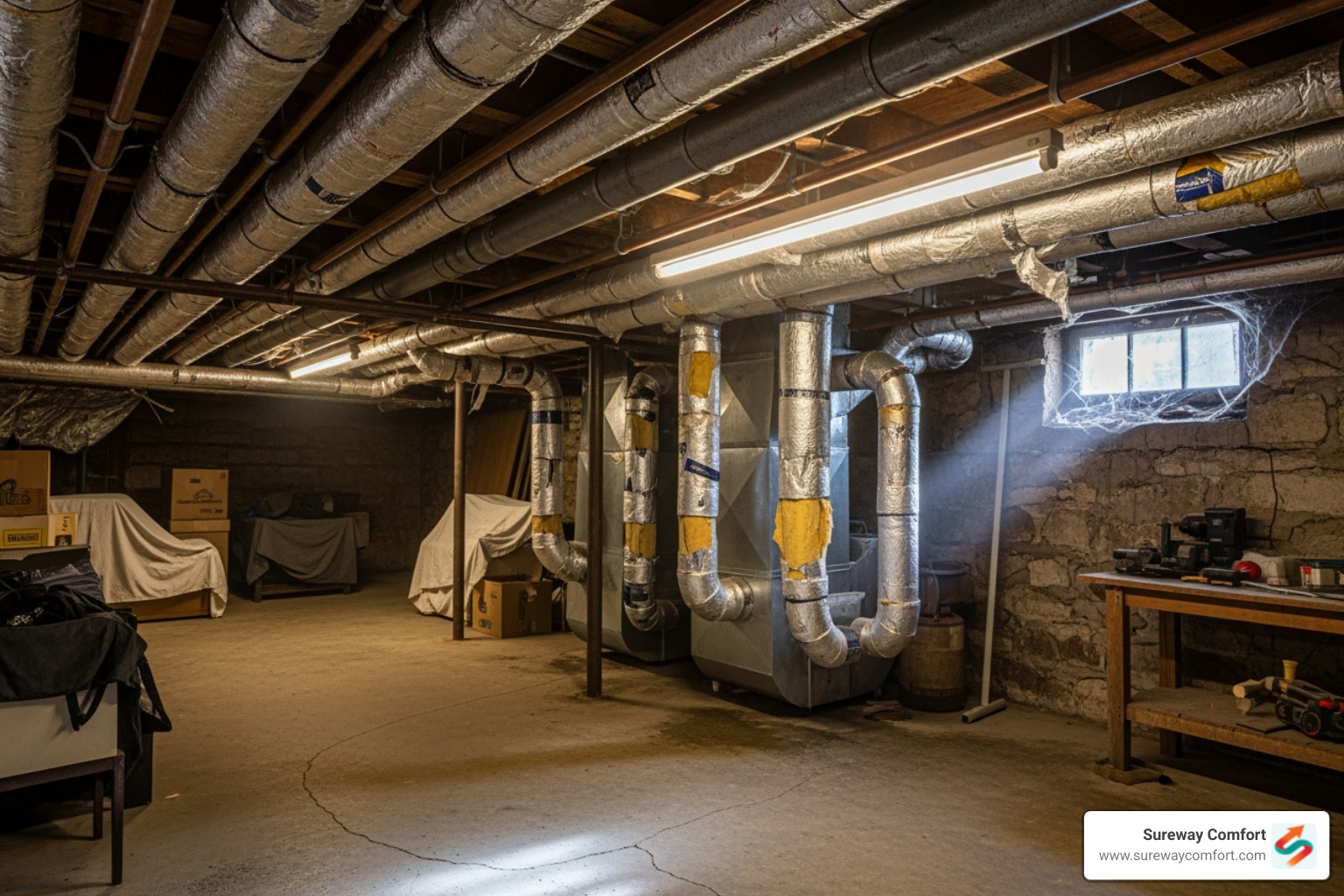
Insulate Vulnerable Pipes
The pipes most likely to burst are the ones that get cold first. These are your exposed pipes in areas where heating doesn't reach effectively. Your attics are prime suspects, especially if they're poorly insulated. Down in basements and crawl spaces, pipes near exterior walls are sitting ducks for freezing temperatures.
Don't forget about pipes running through exterior walls – they're practically outside when winter hits hard. If you have an unheated garage with plumbing, those pipes are also vulnerable.
Pipe insulation sleeves are your best friend here. These foam tubes slip right over your pipes and cost very little compared to flood damage. Installation is straightforward – most homeowners can handle this weekend project themselves. The investment pays for itself the moment it prevents your first freeze.
Winter Weather Preparations
Living in areas like Bridgeville and Upper St. Clair means taking winter seriously. Your pipes need consistent warmth to stay safe, so maintain steady heat throughout your home. Keep that thermostat at least 55°F, even when you're away for the holidays.
Here's a pro tip: open cabinet doors under sinks during cold snaps. This lets warm air circulate around those hidden pipes. While you're at it, seal cracks around your home's foundation and exterior walls. Cold drafts are sneaky – they find every gap and go straight for your plumbing.
When the weather forecast shows extreme cold, let faucets drip slightly. A slow, steady drip from both hot and cold taps relieves pressure and keeps water moving. This simple trick works especially well for pipes along exterior walls.
Before winter arrives, disconnect garden hoses completely. Water trapped in hoses freezes, expands, and can damage both the hose and your outdoor spigots. If you haven't upgraded to frost-free hose bibs yet, consider making that improvement.
Regular Plumbing Maintenance
Your plumbing system works hard year-round, and like any hardworking system, it needs regular attention. Annual inspections with a professional plumber can spot trouble before it becomes an emergency pipe burst. We look for signs of corrosion, weak spots, and other issues that homeowners typically miss.
Water pressure deserves special attention. High pressure feels great in the shower, but consistently high pressure (above 80 psi) stresses your pipes until something gives. A simple pressure check can tell you if you need a pressure regulator installed.
If your home has old pipes made from materials like galvanized steel or polybutylene, consider proactive replacement. Modern materials like PEX and copper are much more reliable. While replacement requires an investment, it's far less expensive than dealing with multiple burst pipe emergencies.
Never ignore small leaks, even those tiny drips that seem harmless. These minor leaks often signal weak points in your pipes – exactly the spots that fail under pressure during freezing weather. Fixing small problems prevents big disasters.
At Sureway Comfort, we've helped countless homeowners in Bridgeville and surrounding areas protect their homes from plumbing emergencies. Our maintenance plans can keep your plumbing system in top condition year-round. Contact us to schedule your plumbing inspection and discuss preventative measures custom to your home.
Frequently Asked Questions about Burst Pipes
When you're dealing with an emergency pipe burst, questions come flooding in (pun intended!) just as fast as the water. Here are the most common concerns homeowners have, along with honest answers to help you make the best decisions for your home and family.
Can I fix a burst pipe myself?
Here's the short answer: you can definitely apply temporary fixes to buy yourself time, but please don't attempt a permanent repair yourself.
Those temporary solutions we mentioned earlier – pipe clamps, epoxy putty, or specialized repair tape – are absolutely worth trying while you wait for professional help. Think of them as putting a bandage on a wound. They'll help control the bleeding (or in this case, the water flow) until the real doctor arrives.
But here's where DIY gets risky. Attempting a full repair on a burst pipe without proper training can actually make things worse. You might create new weak spots, cause future leaks, or even accidentally damage other parts of your plumbing system. Even more concerning, some insurance companies might question coverage if repairs weren't done by a licensed professional.
The bottom line? Temporary fixes are smart first aid, but calling a professional plumber is the surgical solution your home needs for long-term peace of mind.
How long does it take for a pipe to burst when frozen?
This is one of those "it depends" answers that probably isn't what you want to hear when you're worried about your pipes!
The freezing process itself can happen surprisingly quickly. Water starts turning to ice at 32°F, and in extreme cold, a pipe can freeze solid within just a few hours. But here's the tricky part – the actual burst might not happen right away.
What causes the burst isn't the ice itself, but the pressure that builds up as water expands during freezing. This pressure gets trapped between the ice blockage and your closed faucets. Sometimes the pipe bursts immediately from this pressure. Other times, it holds until the ice starts to thaw and the pressure shifts.
Several factors affect timing: the outside temperature, how long the cold snap lasts, what your pipes are made of, how well they're insulated, and your home's water pressure. A pipe might burst within hours of a deep freeze, or it could happen days later during a warming trend.
The key takeaway? Don't wait to see what happens. If temperatures are dropping toward freezing, take those preventive steps we talked about earlier!
Does homeowners insurance always cover burst pipe damage?
Most of the time, yes – but there are some important fine print details you need to know.
Standard homeowners insurance typically covers water damage from "sudden and accidental" events, which definitely includes an emergency pipe burst. This means the damage was unexpected and not caused by neglect on your part.
However, your claim could be denied if negligence is involved. For example, if you ignored a known leak for months, or if you turned off your heat during a winter vacation without taking proper precautions for your pipes. Insurance companies expect homeowners to take reasonable care of their property.
It's also important to understand what's covered versus what's not. Burst pipes are internal plumbing failures, which are usually covered. But damage from external flooding (like rivers overflowing) requires separate flood insurance. Similarly, sewer backups or sump pump failures often need special "water backup" coverage that's added to your basic policy.
Our advice? Contact your insurance company immediately after any pipe burst – ideally within 48 hours. Take those photos and document everything we mentioned earlier. And if you're unsure about your coverage, now's a great time to review your policy before an emergency strikes.
The most important thing to remember is that while insurance can help with the financial aftermath, preventing the problem in the first place is always your best bet. That's where proper maintenance and winterization really pay off!
Your Local Experts for Plumbing Emergencies
When an emergency pipe burst strikes your home, you now have the knowledge to respond quickly. Those critical first moments—shutting off the main water supply, turning off electricity, and draining your system—can mean the difference between manageable damage and a costly disaster.
But temporary fixes like pipe clamps and epoxy putty are just band-aids. A burst pipe needs the skilled hands of experienced professionals who can diagnose the root cause and make lasting repairs. At Sureway Comfort, we understand that plumbing emergencies don't follow a 9-to-5 schedule. Our technicians are ready to help homeowners throughout Bridgeville, Bethel Park, South Fayette, and surrounding areas get their lives back to normal quickly.
We've seen it all, from frozen pipes that burst during brutal Pennsylvania winters to old pipes that finally gave way. Our streamlined process means we arrive prepared to fix your problem the first time. We don't just fix today's problem; we help you prevent tomorrow's disasters by identifying vulnerable areas in your plumbing system.
Don't let a burst pipe turn into a recurring nightmare. Contact us for all your plumbing repair needs in Bethel Park, PA and experience the peace of mind that comes with professional, reliable service you can trust.



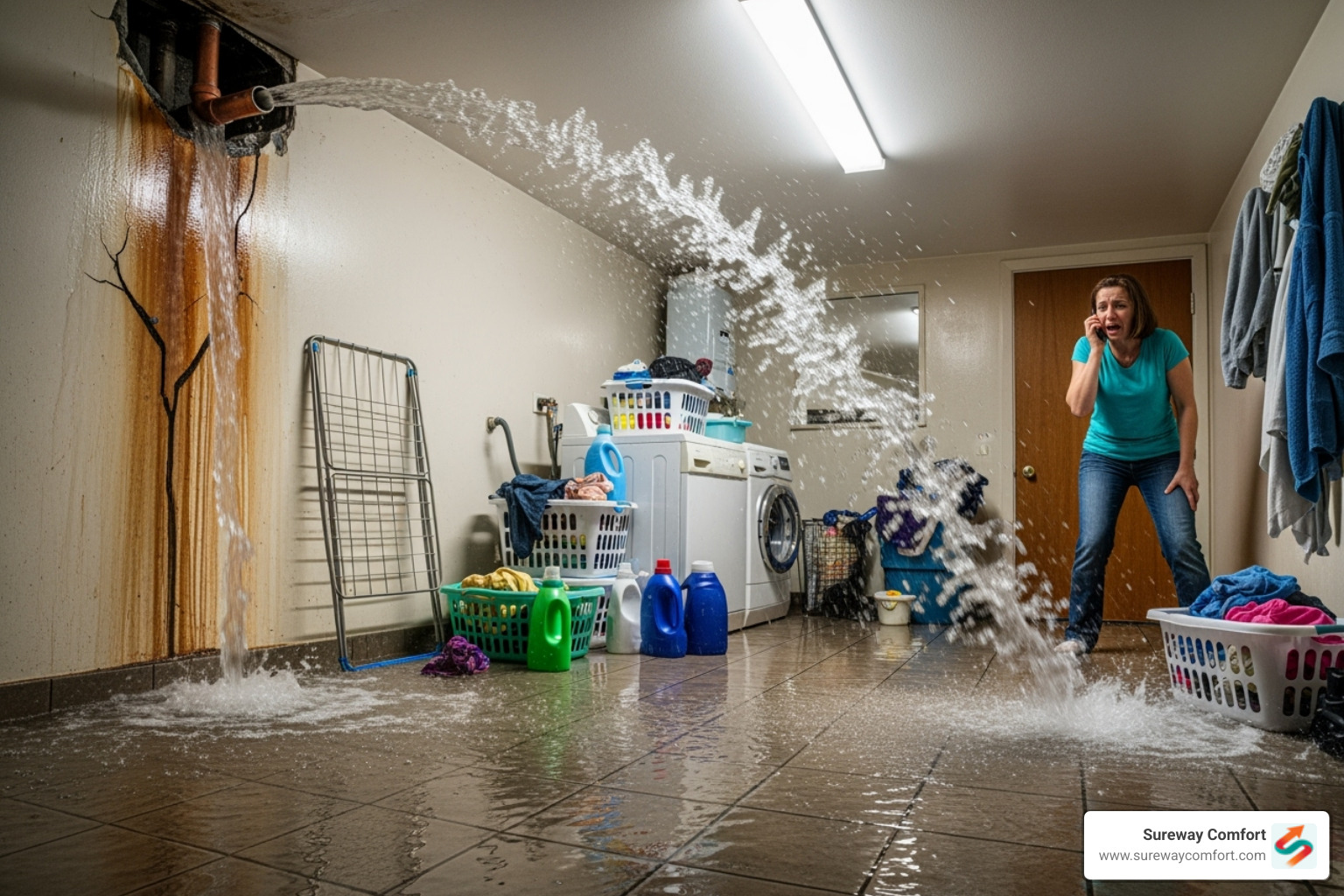
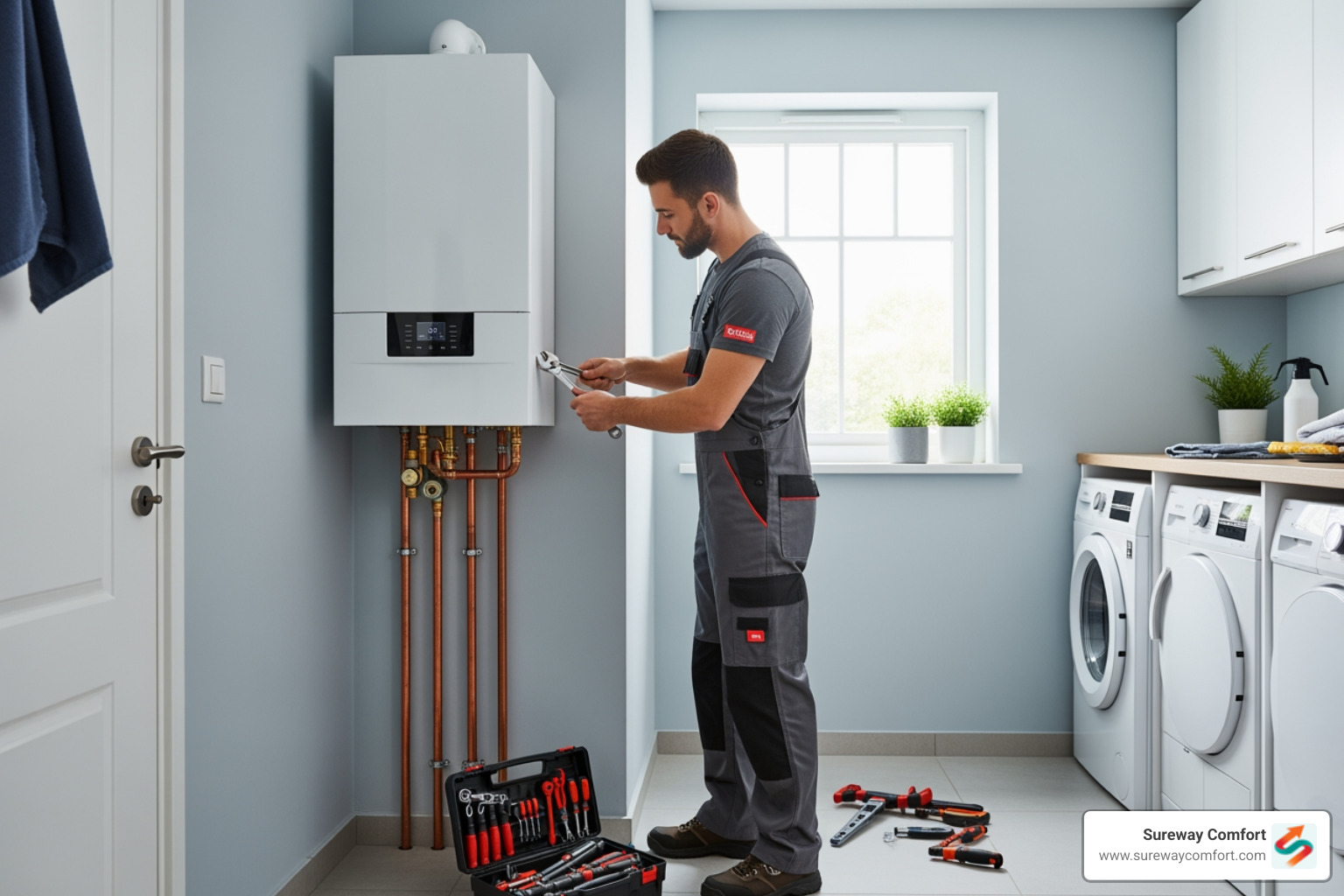

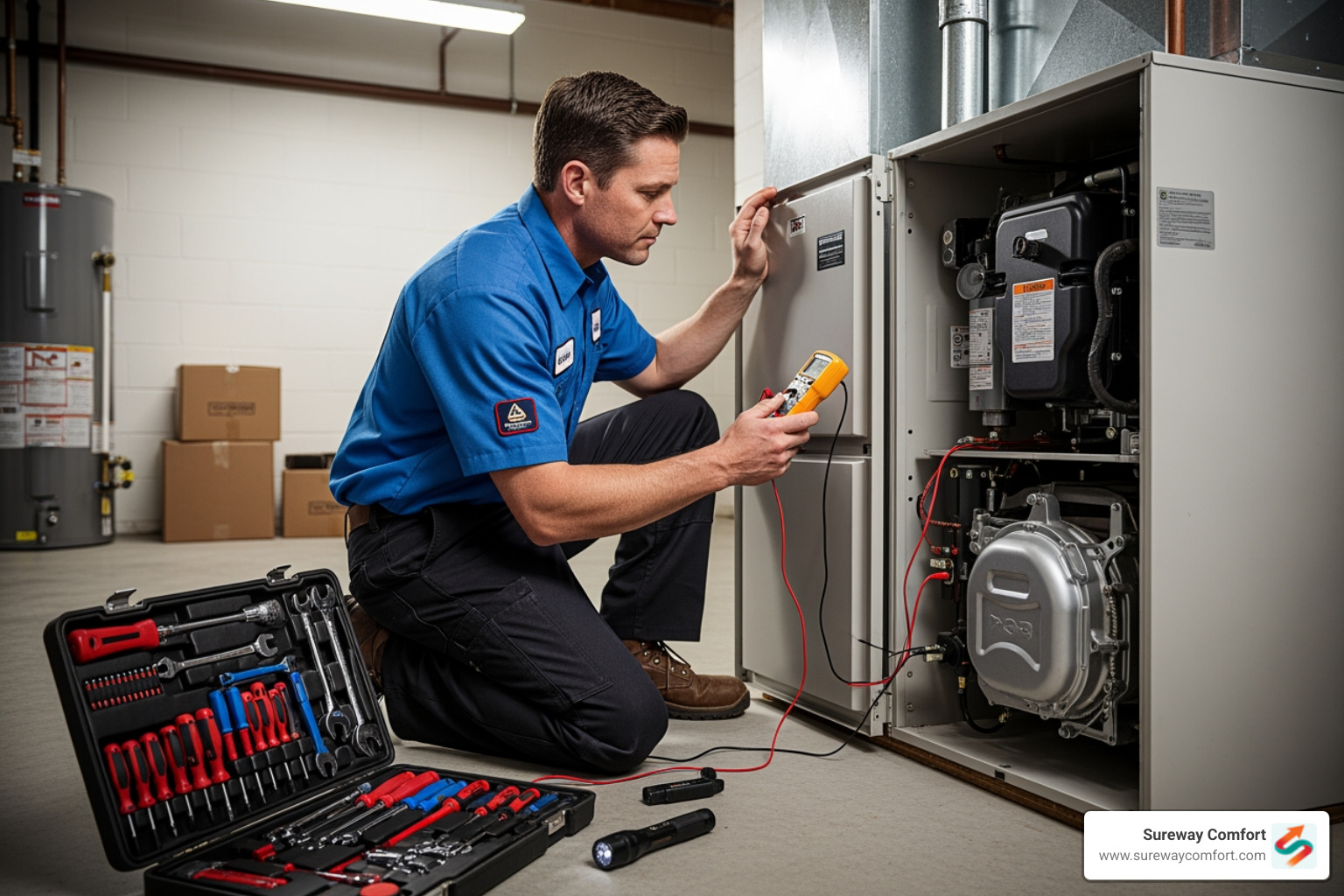
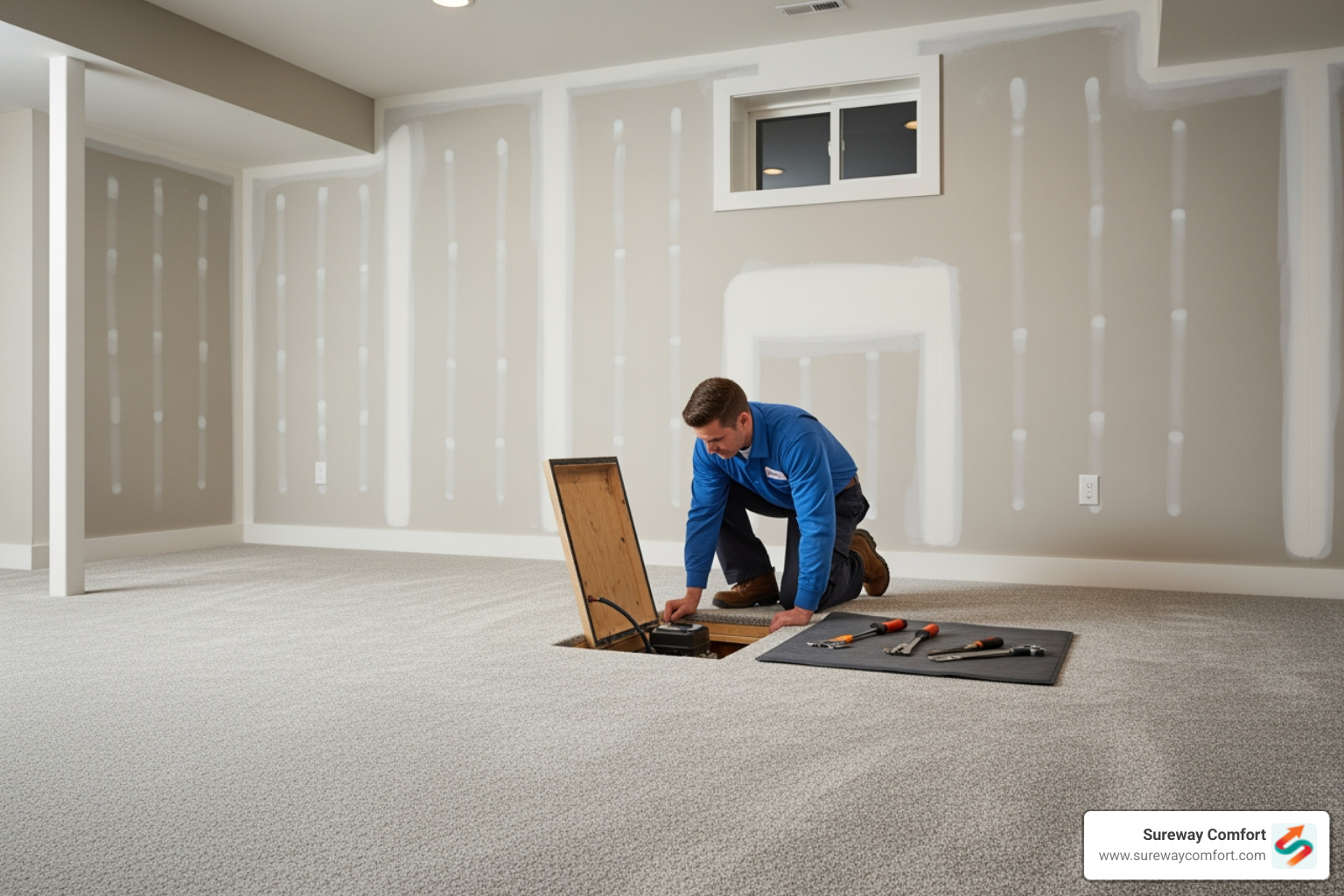




















.avif)



